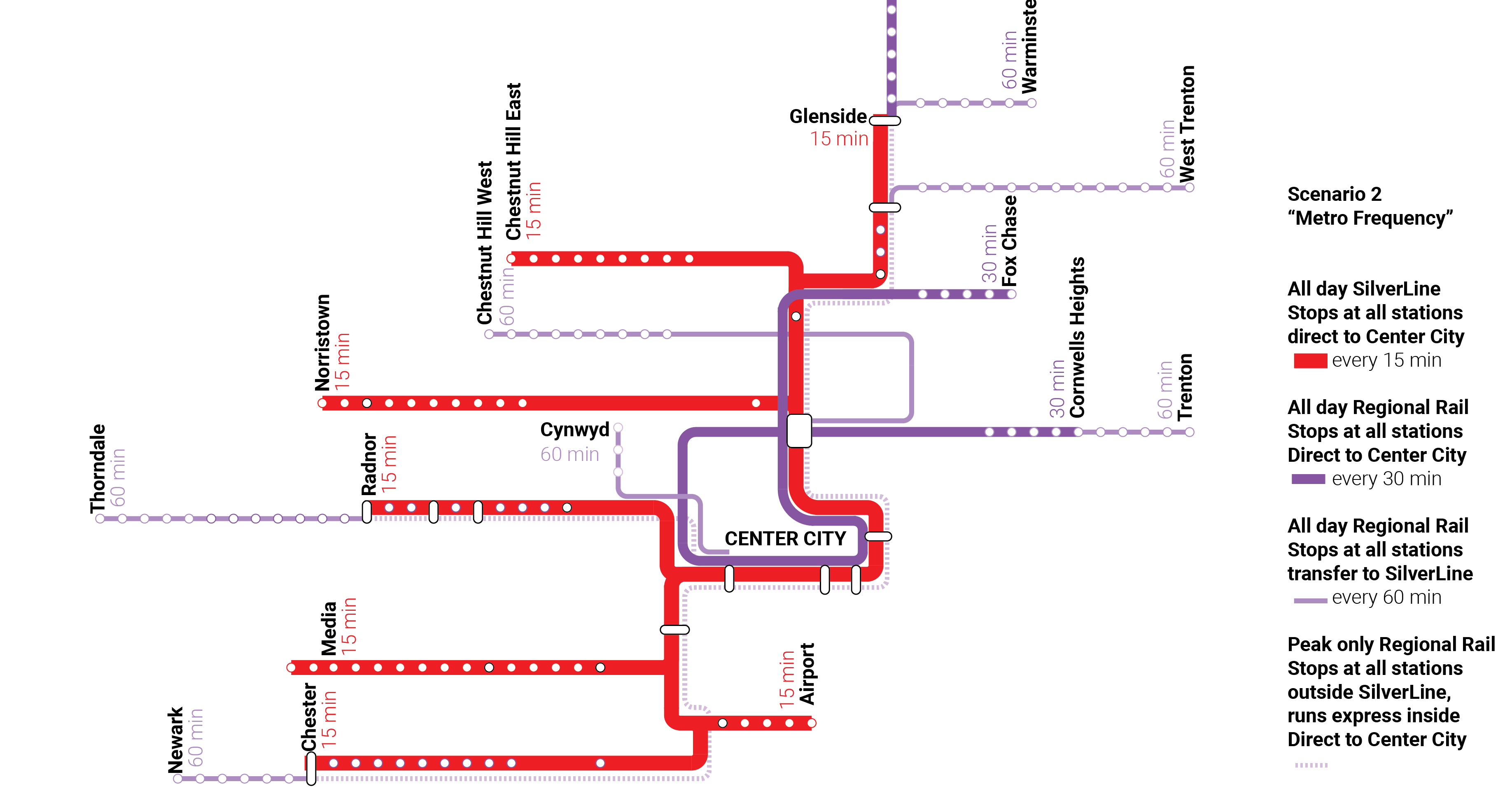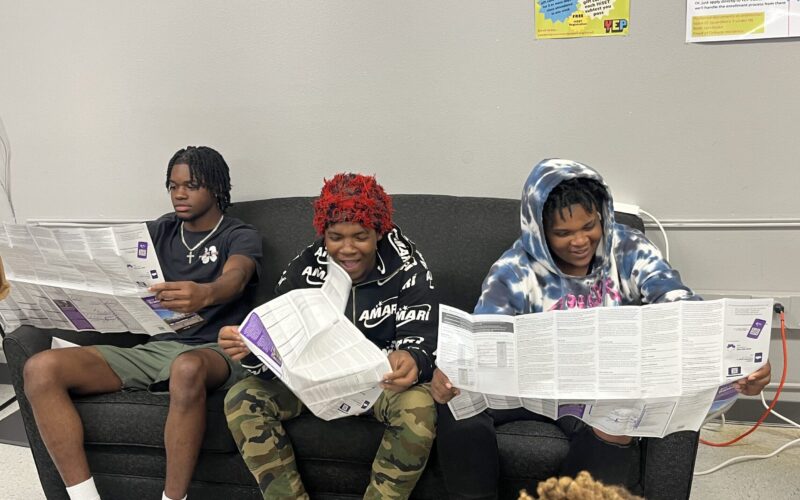
This post was written by guest contributor James Brasuell.
Change is always hard, but that’s especially true in Philadelphia. “Philadelphia is completely averse to change: People hate things the way they are; people hate things that change,” says Will Tung, a volunteer at 5th Square, a local political action committee focused on transit.
And yet Philadelphia’s transit agency, SEPTA, is in the midst of planning seismic changes to its bus and regional rail networks. The agency is currently undertaking two simultaneous, system-wide planning initiatives—Bus Revolution, a full-scale bus network redesign, and Reimagining Regional Rail (in addition to a project to modernize its trolley network, the largest in the country.)
Bus Revolution and Reimagining Regional Rail are components of SEPTA Forward, the agency’s 2021-2026 strategic plan—an ambitious commitment to transit planning and investment that aims to attract new and returning riders to the system and provide greater access to jobs and economic opportunity.
Like most transit systems in the U.S., SEPTA is in need of a reinvention.
As Philadelphia residents stayed home to work or decamped to new locations during the pandemic, they rearranged decades-old patterns of transit ridership. Bus ridership, the majority of SEPTA ridership, proved most resilient and has since returned to 68% of 2019 ridership levels. But ridership had been in decline for years leading up to the pandemic, however, dropping 13% between 2013 and 2019. Ridership on SEPTA’s expansive Regional Rail system fell the most during the pandemic, and is currently serving only 45 percent of 2019 ridership. And SEPTA’s Regional Rail has long served a relatively affluent, largely white population—not at all representative of the city’s overall demographics or many of the neighborhoods served by the system.
“It’s not a coincidence that we’re doing a bus network redesign at the same time that we were doing a regional rail master plan,” says Ryan Judge, director of strategic planning at SEPTA. SEPTA’s COVID-19 recovery planning process, undertaken in the summer of 2020, produced the conclusion that the agency would need to continue to provide transit service as the core of the region’s mobility systems, and ensure that the various transit modes in the system functioned as a cohesive, integrated system. Local transit advocates credit SEPTA’s CEO and General Manager Leslie Richards with keeping the initiatives in SEPTA Forward moving, despite the challenges presented by the pandemic.
A new approach to regional rail
Reimagining Regional Rail has the potential to transform SEPTA’s Regional Rail service. Most SEPTA Regional Rail lines have low frequencies, between 30 minutes to an hour between trains. Service on some lines is more frequent during the morning and afternoon commute. By transitioning Regional Rail service toward all-day high frequency service, Reimagining Regional Rail also has the potential to make the system useful for all kinds of trips–not just commuting to work.
Some of the potential is already embedded in the system. SEPTA Regional Rail benefits from two rare features among U.S. transit systems: it is both through-running, connecting the edges of the region through the urban core, and electrified. “We would love to see the high frequency that you see in transit, similar to the London Overground or Berlin’s S-Bahn—where you have a legacy system, and it’s built for suburban commuters, but you just run it with higher frequency,” says Tung.
That ridership on Philly’s regional rail skews higher income can’t be attributed to the geography of its service area alone. According to a 2020 analysis of indicators of potential disadvantage by the Delaware Valley Regional Planning Commission, 32 out of 150 Regional Rail stations are in at least above-average low-income tracts. “People will crowd onto the 23 bus, right outside of a regional rail station that will take them to the same destination,” says Tung. According to Tung, a goal of the Reimagining Regional Rail process should be to match fares with other modes in the system.
SEPTA presented three potential scenarios for Reimagining Regional Rail in spring 2022—one that focused on coverage, one that focused on frequency in the central city, and one that promises faster, express service on some of the system. “Every single option is an improvement over our current system,” says Tung, but Scenario 2, “Metro Frequency,” is 5th Square’s preference. The Metro Frequency scenario would run trains every 15 minutes on the highest-demand lines in the Regional Rail system, integrate fares with SEPTA’s other modes, and improve station platforms. Scenario one would also integrate fares between SEPTA’s various modes.
Reimagining Regional Rail expects to announce a preferred network from the three scenarios in the third phase of the process to the public later this year.
The bus revolution
Bus Revolution grew out of a pre-COVID response to declining ridership–an initiative called the Frequency Project. The primary goals of Bus Revolution are to attract riders back to the system and to ensure high frequency service to most of the city for current riders. But the system-wide redesign – the first in SEPTA’s history – is planned as cost-neutral, meaning the agency does not intend to add additional service to the network.
Nevertheless, some advocates see the potential for the redesign to live up to the revolution promised in its name. “Expanding the frequent network throughout most of the city, especially on the crosstown routes that intersect with the subways, would be a game changer for a lot of Philadelphia,” says Benjamin She, with 5th Square. Advocates at Transit Forward Philadelphia, an alliance of transit advocacy organizations, are pushing SEPTA to provide at least 85% of bus riders with service that arrives every ten minutes or better throughout the entire day.
So far, the process checks many boxes for the goals of advocates. In the “State of the Bus System” report published in January 2022, SEPTA referenced TransitCenter’s Equity Dashboard to call for more improved job and destination accessibility and service intensity. In another report, SEPTA demonstrated interest in the idea of equitably shifting service from low- to high-demand routes. “It’s not just about putting the lines on the map,” says Dan Nemiroff, manager of planning programs at SEPTA. “It’s about identifying ways to manage the routes proactively so that we maintain consistent frequencies.”
SEPTA expects to release its draft preferred network in the fall.
The Bus Revolution could also clear the way for much-needed capital investment for buses at the street level in Philadelphia, building on recent momentum. The city of Philadelphia painted a bus lane red for the first time in June 2022, on a mile-long stretch of Chestnut Street in Center City. There are only two other painted bus-only lanes in the city of Philadelphia.
The challenges
The biggest obstacle for Reimagining Regional Rail and Bus Revolution thus far has been community engagement. The Bus Revolution officially kicked off in February 2021, when the city was still grappling with the effects of COVID-19.
The disruption of the pandemic just added to the transformational potential of the moment. “SEPTA really needs to utilize this moment as a way to not only reset the bus routes, but also reset the way that it approaches its customers,” says She.
After learning how to do community engagement safely in a pandemic, SEPTA has tallied 20,000 survey responses, 200,000 visits to project websites, and discussions with 10,000 people at pop-up events connected to Reimagining Regional Rail and the Bus Revolution processes. Transit Forward Philadelphia is pushing for more, particularly for SEPTA to communicate the changes and potential trade-offs inherent to a cost-neutral redesign. “The transit agency has been very hesitant to come out and explicitly say, with very bold and clear and simple language, things like, ‘your route may change.'” says Yasha Zarrinkelk, executive director of Transit Forward Philadelphia. While a series of Zoom meetings reflected the agency’s flexibility and adaptability to the public health risks of the pandemic, they have also been poorly attended, according to both Tung and Zarrinkelk. In their recent survey of SEPTA bus riders, the Philadelphia Transit Riders Union found that 75% of respondents had not heard of the redesign.
“[SEPTA is] obviously trying their best in reaching riders where they’re at—prioritizing outreach in ADA accessible communities as well as where there are large pockets of senior and elderly riders. Because we’re talking about route consolidation and bus stop consolidation, those are the folks who are going to be kind of most negatively impacted,” says Zarrinkelk.
Advocates also have abiding concerns about the lack of SEPTA drivers to operate a robust bus system. “We could do all the planning and get all the feedback from riders and customers in the community about how we can have a more reliable and frequent bus network,” says Zarrinkelk, “but if we don’t have a fully staffed operating team that are also well compensated and feel like they’re a priority for the transit agency, then we won’t get close to the goals for the Bus Revolution.”
The path forward
The funding to implement some of the desired bus capital investments will require a new level of political support. According to Judge, the Southeastern Pennsylvania region hasn’t historically devoted a large share of local and regional funding to transit. Because tapping into federal funding from the Infrastructure Investment and Jobs Act requires local matches, it’ll be critical for SEPTA’s partners across the region to identify new sources of funding. Advocates say that more ongoing support from the state of Pennsylvania would also go a long way toward making these goals for a new future for transit in Greater Philadelphia a reality.
Nonetheless, the outlook for improved transit in Philadelphia is optimistic. The city’s street grid, subway lines, and trolley system, as well as the 15-20 routes that carry about half of SEPTA’s bus ridership, provide a solid foundation. “We have really great bones to build off of and we want to make sure that we integrate the bus network to the maximum extent possible,” says Nemiroff. State and local officials have also been supportive of the planning effort so far–whatever political hurdles remain are still beyond the horizon.
Advocates are hoping that with a greater emphasis on community engagement, SEPTA will be able to get the necessary buy-in from riders to achieve ambitious changes like fast, frequent buses that are seamlessly integrated into frequent regional rail service. “It’s an exercise in making people aware how something has to change, and why,” says She.
 On the Brink: Will WMATA’s Progress Be Erased by 2024?
On the Brink: Will WMATA’s Progress Be Erased by 2024?
The experience of being a WMATA rider has substantially improved over the last 18 months, thanks to changes the agency has made like adding off-peak service and simplifying fares. Things are about to get even better with the launch of all-door boarding later this fall, overnight bus service on some lines starting in December, and an ambitious plan to redesign the Metrobus network. But all of this could go away by July 1, 2024.
Read More Winning Free Fares for Youth in New Orleans
Winning Free Fares for Youth in New Orleans
Most transit agencies rely on fare revenue to fund operations, meaning many are forced into the position of needing to collect fares from the people who can least afford it. To change this paradigm, advocates across the country are fighting for - and winning - programs that allow agencies to zero out fares for youth, removing one of the largest barriers to youth ridership.
Read More